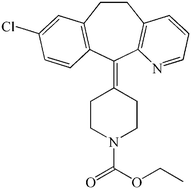Jan 082017
CrystEngComm, 2017, 19,335-345
DOI: 10.1039/C6CE01645F, Paper
DOI: 10.1039/C6CE01645F, Paper
Ruimiao Chang, Qiang Fu, Yong Li, Mingchan Wang, Wei Du, Chun Chang, Aiguo Zeng
In this paper, four amorphous samples of loratadine were prepared by quench-cooling the melted drug at different temperatures.
In this paper, four amorphous samples of loratadine were prepared by quench-cooling the melted drug at different temperatures.
In this paper, four amorphous samples of loratadine were prepared by quench-cooling the melted drug at different temperatures. With these samples, the crystallization tendencies were tested by powder X-ray diffraction (PXRD), and non-isothermal cold crystallization kinetics was investigated by using differential scanning calorimetry (DSC) and the molecular dynamics both in super-cooled liquid and in glassy states was analyzed by using broadband dielectric spectroscopy (BDS) at a temperature range from 213 to 393 K. From the PXRD results, it was established that the four amorphous loratadine samples were apt to crystallize at a temperature below the glass transition temperature. From the DSC results, it was found that the non-isothermal crystallization mechanism of these four loratadine forms was similar. However, the fast crystallization tendency (low physical stability) was also observed for the amorphous loratadine which was obtained at a low quench-cooling temperature. The tendency was analyzed based on the BDS results which demonstrated that rapid molecular mobility could generate a low physical stability and was closely related to Johari–Goldstein relaxation. These results suggested that loratadine had a weak frustration against crystallization and its physical stability was affected by the quench-cooling temperature. This study laid a foundation for choosing the right technique to prepare the amorphous form of loratadine and improving its physical stability.
Crystallization and relaxation dynamics of amorphous loratadine under different quench-cooling temperatures
*Corresponding authors
aSchool of Pharmacy, Health Science Center, Xi’an Jiaotong University, Xi’an 710061, PR China
E-mail: agzeng@mail.xjtu.edu.cn
Fax: +86 29 82655382
Tel: +86 29 82655136
E-mail: agzeng@mail.xjtu.edu.cn
Fax: +86 29 82655382
Tel: +86 29 82655136
bCollege of Pharmacy, Shanxi Medical University, Taiyuan, PR China
cDepartment of Pharmacy, Shanxi Dayi Hospital, Taiyuan 030032, PR China
CrystEngComm, 2017,19, 335-345
DOI: 10.1039/C6CE01645F
//////////














Sorry, the comment form is closed at this time.